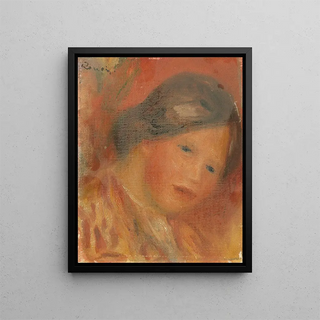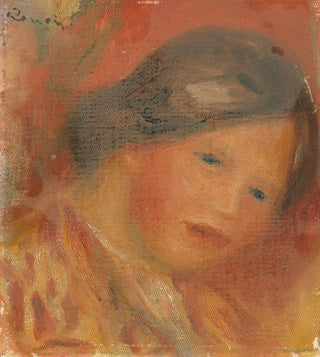Art print | Head of a Woman (Case Conflict) - Pierre-Auguste Renoir


View from behind

Frame (optional)
Reproduction Tête de femme (Case Conflict) - Pierre-Auguste Renoir – Captivating introduction
The art print "Tête de femme (Case Conflict)" by Pierre-Auguste Renoir is a masterpiece that perfectly embodies the essence of Impressionism. Through this piece, Renoir transports us into a universe where light and color blend with unparalleled delicacy. The depiction of a female face, imbued with softness and mystery, invites the viewer to explore the emotions and thoughts hidden behind this gaze. This piece, both intimate and universal, provokes reflection on fleeting beauty and the complexity of human feelings, making it a fascinating study for anyone interested in art.
Style and uniqueness of the work
Renoir stands out with his unique approach to light and color, and "Tête de femme (Case Conflict)" is no exception. The chosen palette evokes a warm atmosphere, where shades of pink and blue intertwine to create a striking visual harmony. The treatment of facial features is both delicate and expressive, revealing a particular sensitivity to female representation. The Impressionist technique, characterized by quick brushstrokes and juxtaposed touches of color, allows Renoir to capture the fleeting moment of beauty. This art print thus bears witness to his skill in immortalizing moments of grace, while playing with the perception of movement and light.
The artist and his influence
Pierre-Auguste Renoir, an emblematic figure of the Impressionist movement, left a lasting mark on his era with his innovative style and artistic vision. Born in 1841, he was influenced by his contemporaries, such as Monet and Degas, while developing a personal approach that was uniquely his own. Renoir was interested in everyday life, bourgeois scenes, and the beauty of women, which he depicted with palpable tenderness. His work not only contributed to the emergence of Impressionism but also paved the way for many artists who followed in his footsteps. Through his paintings, he conveyed a joy of living and a sensitivity that continue to inspire future generations.
An exceptional wall decoration

Matte finish

View from behind

Frame (optional)
Reproduction Tête de femme (Case Conflict) - Pierre-Auguste Renoir – Captivating introduction
The art print "Tête de femme (Case Conflict)" by Pierre-Auguste Renoir is a masterpiece that perfectly embodies the essence of Impressionism. Through this piece, Renoir transports us into a universe where light and color blend with unparalleled delicacy. The depiction of a female face, imbued with softness and mystery, invites the viewer to explore the emotions and thoughts hidden behind this gaze. This piece, both intimate and universal, provokes reflection on fleeting beauty and the complexity of human feelings, making it a fascinating study for anyone interested in art.
Style and uniqueness of the work
Renoir stands out with his unique approach to light and color, and "Tête de femme (Case Conflict)" is no exception. The chosen palette evokes a warm atmosphere, where shades of pink and blue intertwine to create a striking visual harmony. The treatment of facial features is both delicate and expressive, revealing a particular sensitivity to female representation. The Impressionist technique, characterized by quick brushstrokes and juxtaposed touches of color, allows Renoir to capture the fleeting moment of beauty. This art print thus bears witness to his skill in immortalizing moments of grace, while playing with the perception of movement and light.
The artist and his influence
Pierre-Auguste Renoir, an emblematic figure of the Impressionist movement, left a lasting mark on his era with his innovative style and artistic vision. Born in 1841, he was influenced by his contemporaries, such as Monet and Degas, while developing a personal approach that was uniquely his own. Renoir was interested in everyday life, bourgeois scenes, and the beauty of women, which he depicted with palpable tenderness. His work not only contributed to the emergence of Impressionism but also paved the way for many artists who followed in his footsteps. Through his paintings, he conveyed a joy of living and a sensitivity that continue to inspire future generations.
An exceptional wall decoration






